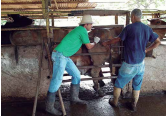Incorporation of a comprehensive reproductive program in dual-purpose farms in the Aroa-Yaracuy valley
Abstract
One of the important pillars in the production of cattle, whether for meat, milk or dual purpose, is the reproductive aspect, which has among its objectives, the incorporation of genes with potentials, which allow in the shortest possible time, offspring for the future replacement of animals with benefits for the production of meat and milk.
The reproductive strategies must be strongly related to the nutrition and health of the herds, as well as to keep a perfect balance between the intrinsic genetic factors of the animal and the environmental factors of the farms, allowing to establish the balance that allows expressing the genetic potential of the animals and consequently the reproductive and productive future of the herd.
It is true that bovine reproduction generates “unsustainable” production costs in some cases, however it is important to design reproductive strategies that are economical, lower costs and improve the reproductive efficiency of the herd. In this sense, it became necessary to address the reproductive conditions of 22 farms in the municipalities Veroes and Manuel Monge of the Yaracuy state, with the purpose of incorporating a comprehensive reproductive program, which allows improving the reproductive and productive condition of said production units.
References
Bo, G.A. y L. Cutaia. 2005. Estrategias para incrementar la preñez en vacas en anestro. 467-468 pp. En: C. Gonzáles Estagnaro y E. Soto Belloso (eds.) Manual de Ganadería Doble Propósito. 2005. Ediciones Astrodata, S.A. Maracaibo, Venezuela.
Palomares-Naveda R. 2005. Cómo prevenir el problema de las vacas repetidoras. 491-492 pp. En: C. Gonzáles Estagnaro y E. Soto Belloso (eds.) Manual de Ganadería Doble Propósito. 2005. Ediciones Astrodata, S.A. Maracaibo, Venezuela.
Rivas R, José H. 2005. Secado de la vaca lechera. 528- 533 pp. En: C. Gonzáles Estagnaro y E. Soto Belloso (eds.) Manual de Ganadería Doble Propósito. 2005. Ediciones Astrodata, S.A. Maracaibo, Venezuela.


